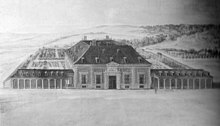Palacio de la Zarzuela
The Palacio de la Zarzuela ([ paˈlaθjo de la θaɾˈθwela ], dt .: Zarzuela Palace ) is located on the north-western outskirts of Madrid in the mountains of El Pardo . It has been the residence of then Crown Prince and later King Juan Carlos and the Spanish royal family since 1962 .
The name Zarzuela (German: "Blackberry bushes") is derived from the field name of the landscape in which the former hunting lodge was built. The Zarzuela , a Spanish musical theater genre comparable to the German Singspiel , takes its name from the palace where this form of musical theater was first performed.
History and shape
The palace is relatively isolated on a slope of Monte de El Pardo , above the districts of El Plantío and Valdemarín, in the Moncloa-Aravaca district. It is surrounded by extensive gardens that form a kind of oasis in the barren vegetation of the mountainous region.
Cardinal Don Fernando of Spain from the House of Habsburg , a brother of King Philip IV , had the building designed as a hunting lodge by Juan Gómez de Mora in 1634 and built by Alonso Carbonell until 1638 . King Charles IV from the House of Bourbon-Anjou had the interior redesigned in the Rococo style in the 18th century .
It is a four-wing building with a low basement, a bel étage and a mezzanine floor above that surrounds a small inner courtyard. The unplastered red brick facade is structured on the entrance front by six pilaster strips made of gray stone blocks, of which the base and the window and door reveals also consist.
After being severely damaged in the Spanish Civil War , the small hunting lodge was restored in 1960 under Francisco Franco by the architect Diego Méndez; the burned-out interiors were redesigned and a low mezzanine floor with a new roof was added. The park was restored based on the condition of the 17th century, it is divided into two elongated garden terraces, which are separated by walls with colonnades; a staircase connects the castle with the two terraces and a garden ground floor .
In 1962, the dictator Franco made the complex available to Prince Juan Carlos de Borbón y Borbón as a residence after his marriage to Sophia of Greece . In 1969, after the birth of their son Felipe, he appointed Juan Carlos as Príncipe de España and presumptive successor. After their accession to the throne in 1975, Juan Carlos and Sophia decided not to move to the uninhabitable and gardenless royal palace in downtown Madrid, which is, however, used for representative purposes and as the seat of the court authorities. They preferred to stay in the Zarzuela Palace with their children.
In the basement there are storage rooms and the kitchen, on the ground floor the study of the king and his employees, the library, the dining room and the visitors' room. The top floor houses guest and study rooms. In the 1990s, two side wings were added to the long sides of the palace, in the place of which there were originally two narrow colonnade wings. The new, wider wings were provided with extended mansard roofs . The royal family's private apartments are in one wing, the administration and security services in the other. There are numerous outbuildings on the palace grounds, including a chapel , sports facilities, and a helipad. The palace is not open to the public.
For the then Crown Prince Felipe , a two-story house in the style of a Spanish country villa was built on the grounds of the palace, which he has lived in since the summer of 2002 and which he has maintained as a residence with his family even after he took over the throne in June 2014. However, his study, from which he carries out his official business, is in the Zarzuela Palace. The monarch performs his daily work duties such as receptions for domestic and foreign officials, swearing-in of ministers or holding cabinet meetings in the Zarzuela Palace, while large state receptions and dinners take place in the Palacio Real , the official residence of the Spanish royal family, which takes place around the 20th century Kilometers from the Zarzuela Palace in the center of Madrid.
Further northeast in the El Pardo Mountains, about eight kilometers from the Zarzuela Palace, is the former royal summer residence Palacio El Pardo , which long served as the residence of the dictator Francisco Franco and now serves as a guest house for the Spanish government.
literature
- Juan A. Hernández Ferrero: Palacios reales de Patrimonio Nacional . Editorial Lunwerg, Barcelona 1997, ISBN 84-7120-218-2 .
- German translation: Spanish royal palaces. Evidence of a national history . Könemann, Cologne 1999, ISBN 3-8290-2231-X .
- Gisela Noehles-Doerk: Reclam's Art Guide Spain, Vol. 1: Madrid and Central Spain. Reclam, Stuttgart 1986, ISBN 3-15-010339-8 , p. 155.
Web links
- Real Sitio de El Pardo. citysam.de
- Zarzuela palace. hellomagazine.com (English)
- Boda real. elmundo.es (Spanish, about the villa of Felipe VI.)
Individual evidence
- ↑ King Felipe VI: How Spain changes with the change of the throne. In: Süddeutsche.de. June 17, 2014, accessed June 19, 2014 .
Coordinates: 40 ° 28 ′ 59.5 ″ N , 3 ° 48 ′ 6.5 ″ W.


